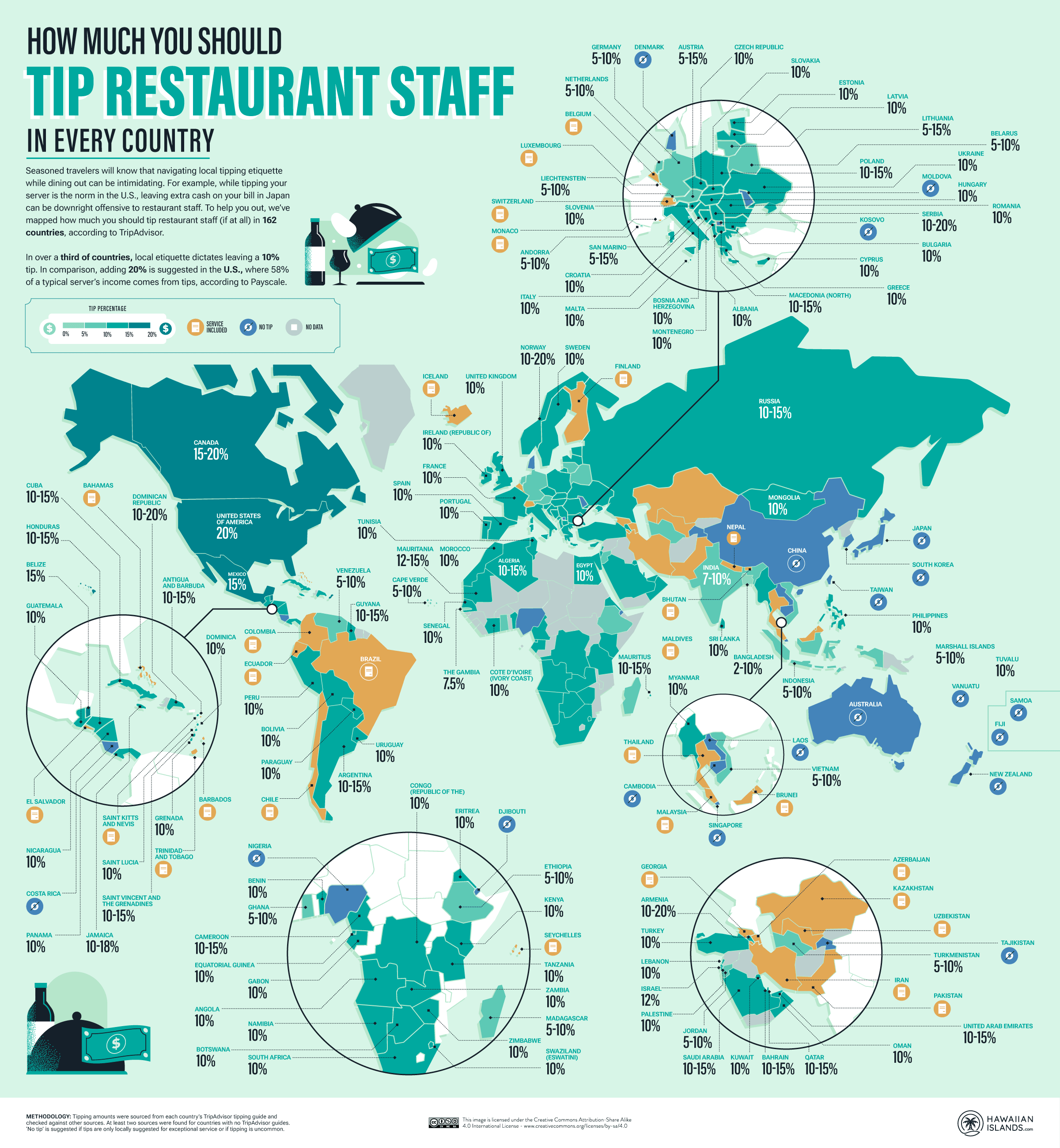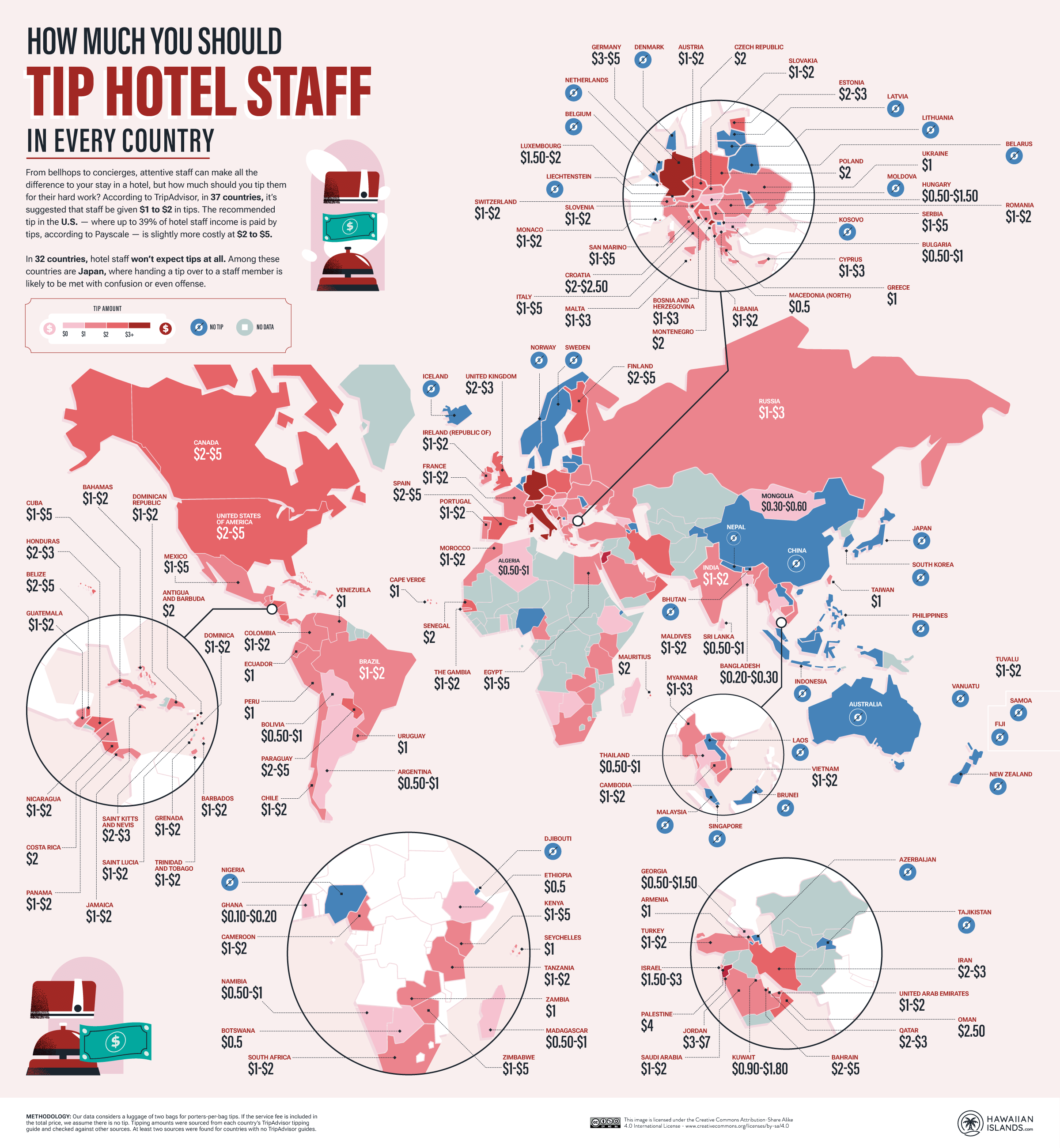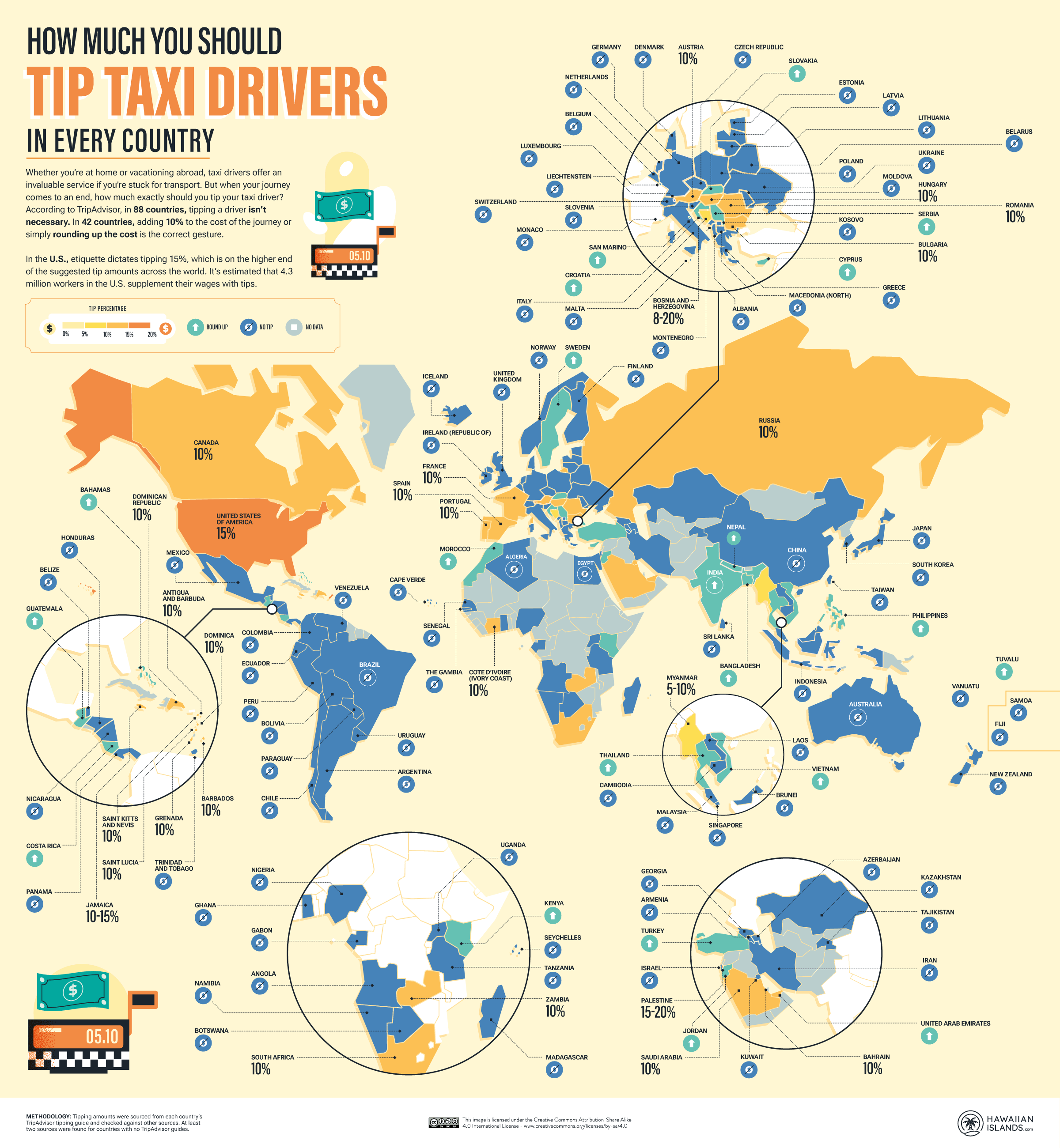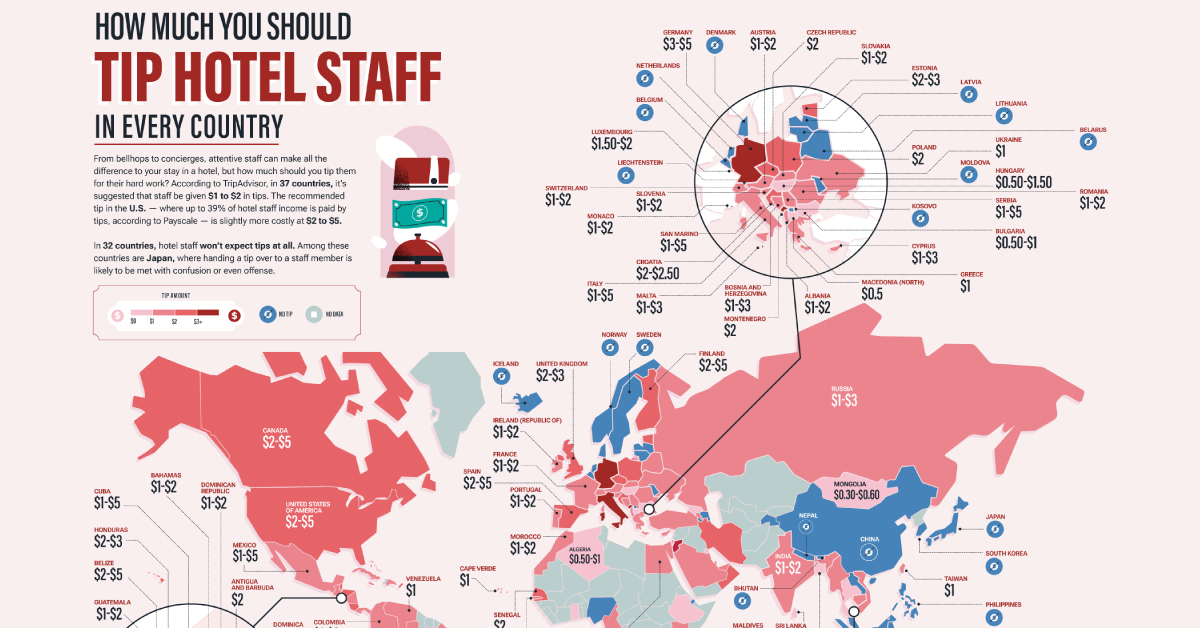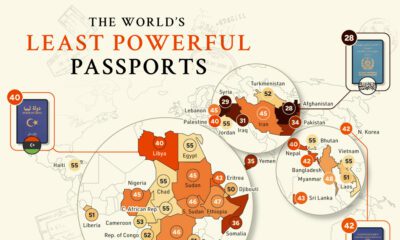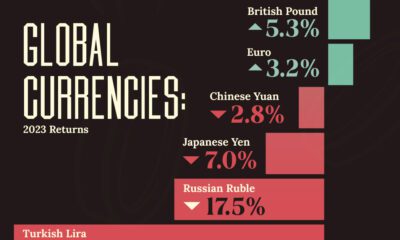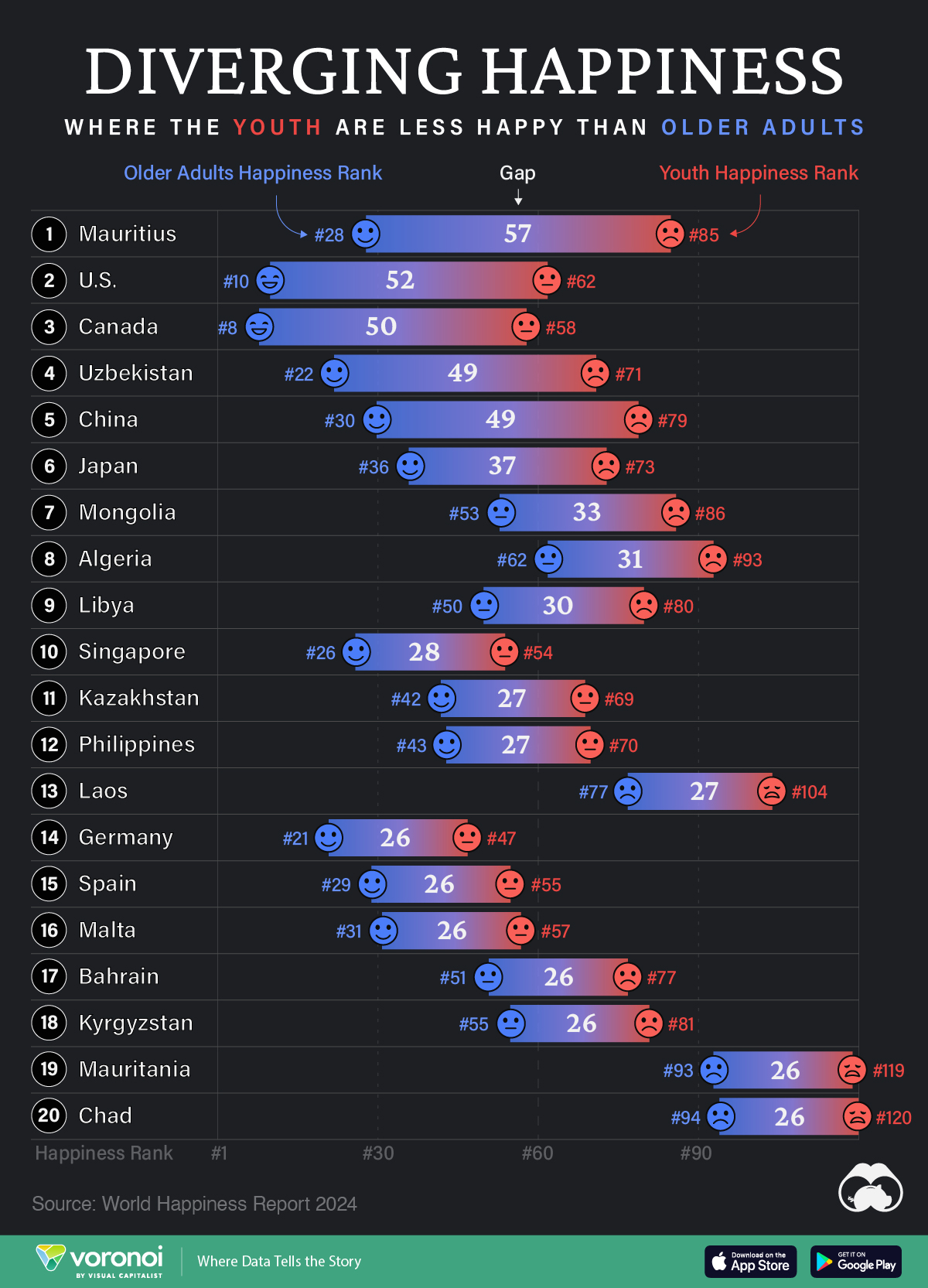Culture
Mapped: How Much Should You Tip In Each Country?
Click to view this graphic in a higher-resolution.
How Much Should You Tip In Each Country?
How much should you tip when traveling abroad? The answer can vary wildly depending on the country and what type of service you are using.
In some countries like the U.S., tipping has become an integral part of work and service culture. Whether you are grabbing a coffee, ordering food delivery, or visiting a hotel on vacation, tipping becomes a part of your expenses.
But in others, tipping is not encouraged and can even be frowned upon. So how do you know which tipping culture you’re interacting with?
These maps from Hawaiian Islands studied the tipping trends across 162 countries, looking first at TripAdvisor’s tipping etiquette guides for each country then cross-referencing with other articles on tipping in those locales.
How Much Should You Tip at Restaurants?
Exploring local cuisine and trying out different restaurants can be an important part of an international holiday, but so is understanding each nation’s tipping etiquette.
For example, while servers and bartenders in the United States—the only country with a 20% recommended tip—often depend on tips to supplement wages, tipping at a restaurant could be considered an insult in Japan, China, or South Korea, where employers include higher service standards as part of wages.
Also consider that the maximum expected tip can vary. If you are at a restaurant in Canada, Serbia, or the Dominican Republic, tips of around 20% would be at the top of the typical expected range. Meanwhile, 66 countries welcome a 10% tip.
Some countries also have “mandatory tips” in the form of service charges or gratuity for larger parties. Others like India have banned restaurants from mandatory tipping.
Tipping For Lodging
Click to view this graphic in a higher-resolution.
Whether you’re staying abroad, tipping may be expected for you to get the best service from the concierge desk, bellhop, or cleaning staff .
If you are in the U.S. or Canada, lodging staff tips range from $2‒$5 USD. On the other extreme, in countries like Argentina, Thailand, and Sri Lanka, you can get away with a tip of 50 cents.
For many other countries in the world, including Brazil, Mexico, and India, tipping etiquette and expectations usually amount to $1 to $2 in hotel staff tips.
Tipping For Transport
Click to view this graphic in a higher-resolution.
When you’re not traveling with your own rented car or public infrastructure, travelers look to local taxis and ridesharing services like Uber and Lyft for convenient ways to explore new places.
Interestingly, these drivers do not expect any tips in 88 countries around the world. Many countries including India, Sweden, and Morocco simply round up the cab fare as a small tip.
In 21 other countries including Canada, cabbies are usually tipped 10% over the price of the ride. But the U.S. tops the list with a tipping etiquette of 15% for taxi rides.
How Much Should You Tip For Different Services?
How does each country’s tipping culture vary by service, and how do they compare? And which countries don’t have tipping data available?
This interactive table helps you explore the map data directly by searching for your country of choice:

This article was published as a part of Visual Capitalist's Creator Program, which features data-driven visuals from some of our favorite Creators around the world.
Demographics
Ranked: Countries Where Youth are the Most Unhappy, Relative to Older Generations
Conventional wisdom says that young adults (those below 30) tend to be the happiest demographic—but this is not true for these countries.
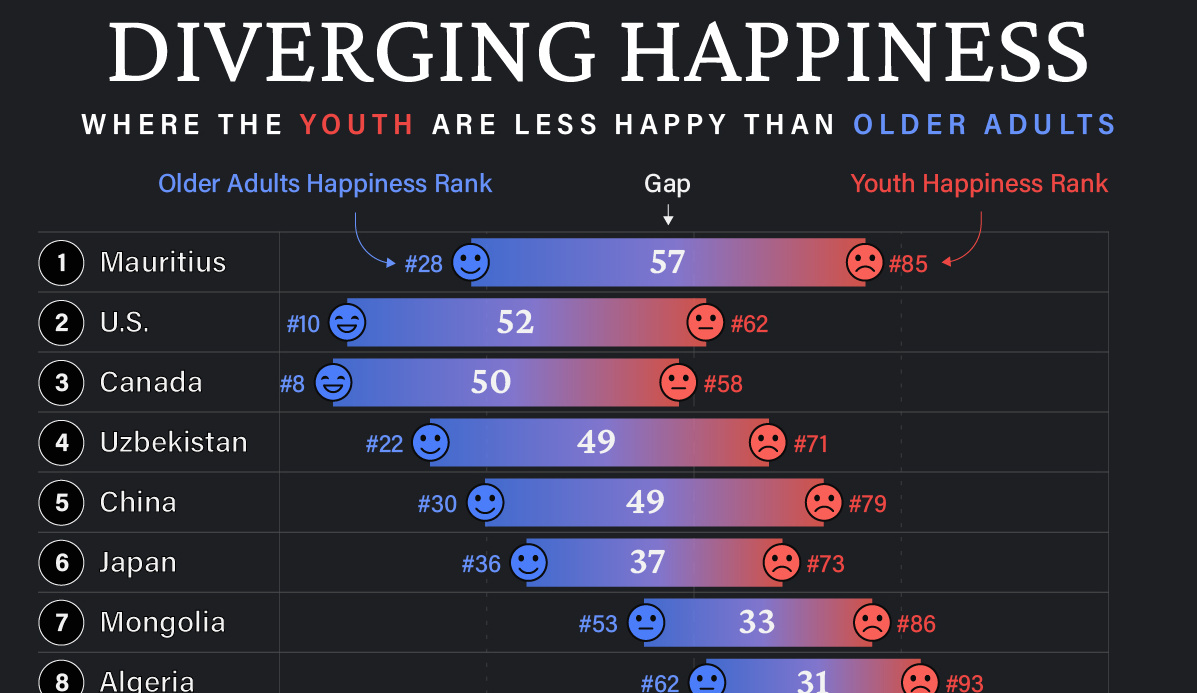
Countries with the Biggest Happiness Gaps Between Generations
This was originally posted on our Voronoi app. Download the app for free on iOS or Android and discover incredible data-driven charts from a variety of trusted sources.
“They say a person needs just three things to be truly happy in this world: someone to love, something to do, and something to hope for.” — Tom Bodett
Measuring happiness is tricky business, more so when taking into account how different regions, cultures, and faiths define it. Nevertheless, the World Happiness Report attempts to distill being happy into a single score out of 10, and then ranks countries by their average score.
We’ve visualized the high-level findings from the latest happiness report in this series of maps. However, the report also dives deeper into other significant trends in the data, such as a growing disparity in happiness between age groups within countries themselves.
In the chart above, we list countries by the biggest gaps in happiness ranks between young adults (<30) and older adults (60+). A higher number indicates a larger gap, and that the youth are far unhappier than their older counterparts.
Where are Youth Unhappier than Older Adults?
Mauritius ranks first on this list, with a massive 57 place gap between older adult and youth happiness. The 1.26 million-inhabited island nation briefly reached high income status in 2020, but the pandemic hit hard, hurting its key tourism sector, and affecting jobs.
The country’s youth unemployment rate spiked to close to 25% that year, but has since been on the decline. Like residents on many similarly-populated islands, the younger demographic often moves abroad in search of more opportunities.
| Rank | Country | Youth Happiness Rank | Older Adult Happiness Rank | Happiness Gap |
|---|---|---|---|---|
| 1 | 🇲🇺 Mauritius | 85 | 28 | 57 |
| 2 | 🇺🇸 U.S. | 62 | 10 | 52 |
| 3 | 🇨🇦 Canada | 58 | 8 | 50 |
| 4 | 🇺🇿 Uzbekistan | 71 | 22 | 49 |
| 5 | 🇨🇳 China | 79 | 30 | 49 |
| 6 | 🇯🇵 Japan | 73 | 36 | 37 |
| 7 | 🇲🇳 Mongolia | 86 | 53 | 33 |
| 8 | 🇩🇿 Algeria | 93 | 62 | 31 |
| 9 | 🇱🇾 Libya | 80 | 50 | 30 |
| 10 | 🇸🇬 Singapore | 54 | 26 | 28 |
| 11 | 🇰🇿 Kazakhstan | 69 | 42 | 27 |
| 12 | 🇵🇭 Philippines | 70 | 43 | 27 |
| 13 | 🇱🇦 Laos | 104 | 77 | 27 |
| 14 | 🇩🇪 Germany | 47 | 21 | 26 |
| 15 | 🇪🇸 Spain | 55 | 29 | 26 |
| 16 | 🇲🇹 Malta | 57 | 31 | 26 |
| 17 | 🇧🇭 Bahrain | 77 | 51 | 26 |
| 18 | 🇰🇬 Kyrgyzstan | 81 | 55 | 26 |
| 19 | 🇲🇷 Mauritania | 119 | 93 | 26 |
| 20 | 🇹🇩 Chad | 120 | 94 | 26 |
Conventional wisdom says, and data somewhat correlates, that young adults (those below 30) tend to be the happiest demographic. Happiness then decreases through middle age and starts increasing around 60. However, the above countries are digressing from the pattern, with older generations being much happier than young adults.
That older generations are happier, by itself, is not a bad thing. However, that younger adults are so much unhappier in the same country can point to several unique stresses that those aged below 30 are facing.
For example, in the U.S. and Canada—both near the top of this list—many young adults feel like they have been priced out of owning a home: a once key metric of success.
Climate anxieties are also high, with worries about the future of the world they’ll inhabit. Finally, persistent economic inequities are also weighing on the younger generation, with many in that cohort feeling like they will never be able to afford to retire.
All of this comes alongside a rising loneliness epidemic, where those aged 18–25 report much higher rates of loneliness than the general population.
Source: The World Happiness Report which leverages data from the Gallup World Poll.
Methodology: A nationally representative group of approximately 1,000 people per country are asked to evaluate their life on a scale of 0–10. Scores are averaged across generations per country over three years. Countries are ranked by their scores out of 10.
-

 Personal Finance1 week ago
Personal Finance1 week agoVisualizing the Tax Burden of Every U.S. State
-

 Misc6 days ago
Misc6 days agoVisualized: Aircraft Carriers by Country
-

 Culture6 days ago
Culture6 days agoHow Popular Snack Brand Logos Have Changed
-

 Mining1 week ago
Mining1 week agoVisualizing Copper Production by Country in 2023
-

 Misc1 week ago
Misc1 week agoCharted: How Americans Feel About Federal Government Agencies
-

 Healthcare1 week ago
Healthcare1 week agoWhich Countries Have the Highest Infant Mortality Rates?
-

 Demographics1 week ago
Demographics1 week agoMapped: U.S. Immigrants by Region
-

 Maps1 week ago
Maps1 week agoMapped: Southeast Asia’s GDP Per Capita, by Country

